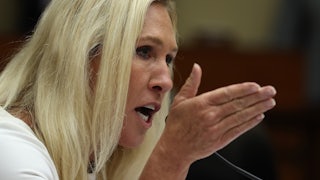With Hurricane Milton set to make landfall in Florida this week—with likely devastating force—the intensity of the concern over the potential fury of this latest storm is only matched by discussion of the flood of misinformation that swept across social media after the last hurricane made landfall. In the wake of Hurricane Helene, which wreaked havoc across several southeastern states, conspiracy theories and falsehoods about the federal response to the storm have spread across sites like X and TikTok. In many cases, these lies were promoted by major political figures, including former President Donald Trump.
Despite efforts by federal officials, as well as state and local leaders, experts in emergency management, and in misinformation, worry that the increasingly charged atmosphere of unreliable information surrounding natural disasters could prove to be a persistent danger to the public for the foreseeable future.
“There are some indications here that this is just part of what disaster response is going to look like moving into the future,” said Samantha Montano, assistant professor in the Department of Emergency Management at the Massachusetts Maritime Academy. Climate change is spiking the frequency and intensity of major storms, and with those disasters will come a charged atmosphere of falsehoods and conspiracies.
The Federal Emergency Management Administration has been the focal point of many of the lies and misinformation that have spread since Helene made landfall. The situation is severe enough that the agency has had to establish a “rumor response” page to combat falsehoods. Although state and local officials, including many Republicans, have urged constituents not to believe or spread false information, dodgy theories have continued to bounce across social media.
Deanne Criswell, the head of FEMA, said on Tuesday that the amount of misinformation had reached a level that she had “never seen before,” leading her to worry that people might not apply for necessary aid. “If it creates so much fear that my staff doesn’t want to go out in the field, then we’re not going to be in a position where we can help people,” she said. “I worry that they won’t apply for assistance, which means I can’t get them the necessary items they need to support them.”
Several factors contribute to the current atmosphere of misinformation around Helene. There is the charged political atmosphere surrounding the presidential election, exacerbated by Trump’s promotion of conspiracy theories about the Biden administration’s response to the hurricane. Trump has falsely claimed that the president has not been in contact with the governors of affected states, that the administration has evinced anti-Republican bias in red-leaning areas of North Carolina, that Vice President Kamala Harris was spending FEMA funds to house undocumented immigrants, and that the federal government is only giving $750 to those who lost their homes—all of which is incorrect.
“There is a lot at stake in that election, and there is a real incentive for the public to perceive how disaster response and recovery is unfolding, particularly in states where there is closer distance between the candidates running,” said Montano. North Carolina, Georgia, and Florida are all—to varying degrees—in play in the upcoming election next month.
The loss of cell service for many impacted by the storm also led to people relying more on hearsay because they could not access reliable sources of information. Moreover, the erosion of local news and the unreliability of social media have led to a fragmented media ecosystem, meaning that there are fewer reporters on the ground to cover major events and greater opportunities for falsehoods to fill this yawning information vacuum.
Changes to X, the social media site formerly known as Twitter, may have had a significant impact on the spread of misinformation in the wake of natural disasters. During previous natural disasters, people relied on Twitter for information sharing, said Amber Silver, an assistant professor of the Department of Emergency Management and Homeland Security at the University at Albany who has conducted research on how citizens used the website during crises. Since its inception, Silver said, Twitter “almost organically became where many people would go to get the information about breaking news such as large-scale disasters.”
“People would see their friends, their family, and total strangers talking online about how they were going to purchase supplies, or they were boarding up windows, or they were tying down furniture, and they felt internal pressure to prepare themselves,” said Silver. But there has not yet been significant research about how the site has affected people’s responses to disasters since it became X last year.
Since Elon Musk purchased X, it has become a hotbed for conspiracy theories; Musk himself has promoted falsehoods about the federal response to Helene. Several changes that the billionaire has made to the website, including allowing any user to purchase the “blue checkmark” that previously signaled verification as a public figure, have complicated the ability to find accurate information from reliable sources. False information is less likely to be fact-checked by the site, and it is more difficult for researchers to access data on user trends, said Silver.
Conspiracy theories can be appealing to the public because they provide an explanation for a horrific event, as well as an easy target for blame, said David Harker, chair of the Department of Philosophy and Humanities at East Tennessee State University, who has studied misinformation.
“If a story starts circulating which connects these events to groups or people who we’re already inclined to regard with a lot of suspicion, or who we’ve already deemed untrustworthy or incompetent, then those stories are going to be really appealing,” said Harker. “We’re even less cautious than usual about accepting rumors and stories, and we’re even more inclined to share those with other people as a way of releasing some of the anger.”
Where many of the rumors surrounding Hurricane Helene were related to disaster recovery, conversations around Hurricane Milton have been subject to conspiracies about government control of the weather. “What 10, 15, 20 years ago would be considered a very far-out, very fringe, very radical sort of conspiracy theory is appearing in sort of the social media discourse at higher volume than necessarily we would have expected,” said Silver.
A report by the Institute for Strategic Dialogue released on Tuesday found that FEMA and public officials had been subject to antisemitic invective in the wake of Hurricane Helene. The report found that 33 posts on X containing claims debunked by FEMA had generated more than 160 million views and that 10 of these posts contained antisemitic rhetoric. Moreover, some of the largest accounts spreading conspiracy theories about the hurricane response have also posted anti-migrant sentiments, conspiracies about electoral fraud, and other antisemitic tropes, which the ISD said “reveals how diverse groups converge on moments of crisis to co-opt the news cycle and launder their positions to a wider or mainstream audience.”
Given the echo-chamber aspects of social media, it’s unclear how truly widespread these conspiracy theories are in the public consciousness. Bad actors have taken advantage of disasters since long before the rise of social media, and the modern-day online trolls and right-wing extremist groups promoting misinformation are just a recent expression of that trend. Moreover, China and Russia have conducted campaigns amplifying false claims about the storm as part of a larger effort to sow discord in American society. Lies and conspiracy theories are also promoted by bots, making an extreme view seem more widespread than it is in reality.
“Sometimes the most extreme viewpoints have the loudest voices, but they might not reflect the most people,” said David Rapp, professor in the Department of Psychology at Northwestern University, who studies misinformation and media literacy.
The level of untrustworthy and false information surrounding hurricane recovery may be emblematic of the larger ecosystem of misinformation that permeates modern society. The current political era has seen the proliferation of conspiracy theories surrounding election integrity—again, often promoted by Trump—as well as a rise in A.I.-generated content that can make it difficult for the public to discern what is real. (A.I.-generated images have been used to prompt rage at the Biden administration’s response, including one deepfake promoted by Utah Senator Mike Lee in a now-deleted tweet.)
“It is how life is now, and until somebody sees this as a serious issue that needs to be tackled, I think it’s going to remain the case, because the technologies that allow misinformation to spread are not going away. People are not turning away from them,” said Heidi Julien, professor of information science at the University at Buffalo Graduate School of Education. “The only thing that’s going to change it is to start helping people to become more digitally literate.”
Julien believes that improving digital literacy should begin in school, so that children can learn early on how to discern factual information from misleading or false information. But for adults, she envisions a public service campaign that could involve the government and nonprofits working together through mass communication and advertisements. “Take the public campaign to stop people smoking. That’s the kind of thing that needs to be done,” argued Julien.
Given current levels of polarization, efforts to combat misinformation may be met with hostility or disbelief. Even the act of researching misinformation can be politicized, with some seeing fact-checking itself as biased. Officials who try to correct the record may need to toe a fine line between the firm debunking of falsehoods and patience for addressing misconceptions.
“The messaging needs to be careful. It probably shouldn’t take on an air of arrogance, or it needs to be more supportive and meet people where they’re at. But at the same time, we also have to realize there are certain people who are not going to be willing to change their ideas or change their beliefs,” said Rapp.
However, he continued, the population who may reject these efforts should not be dismissed out of hand. “Even if I present something to someone that they don’t want to believe, that they maybe want to reject, at least conveying that idea to them, maybe some little piece of that will be taken up, or they’ll consider it later,” he said.








